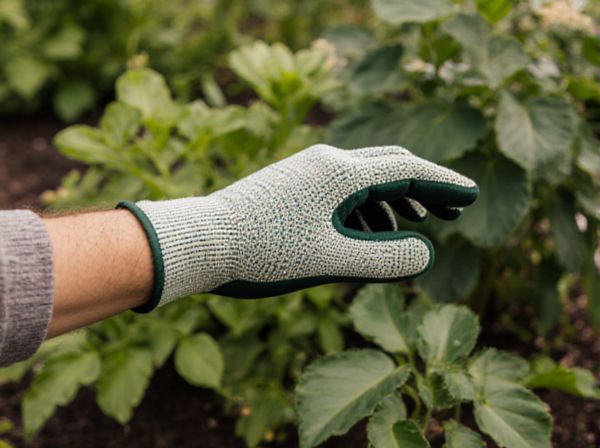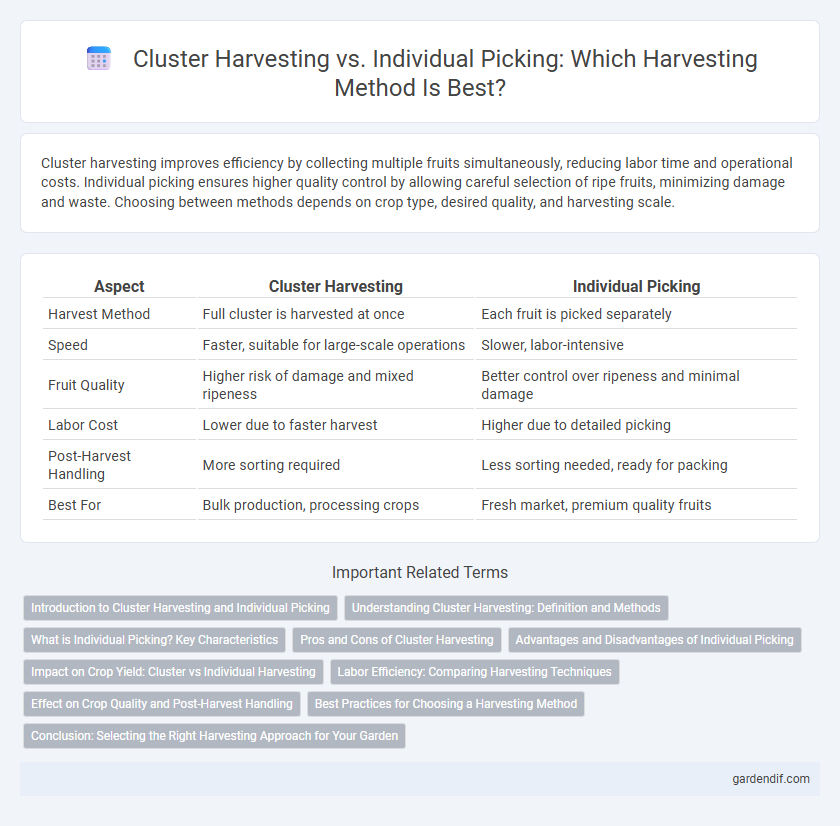
Cluster Harvesting vs Individual Picking Illustration
Cluster harvesting improves efficiency by collecting multiple fruits simultaneously, reducing labor time and operational costs. Individual picking ensures higher quality control by allowing careful selection of ripe fruits, minimizing damage and waste. Choosing between methods depends on crop type, desired quality, and harvesting scale.
Table of Comparison
| Aspect | Cluster Harvesting | Individual Picking |
|---|---|---|
| Harvest Method | Full cluster is harvested at once | Each fruit is picked separately |
| Speed | Faster, suitable for large-scale operations | Slower, labor-intensive |
| Fruit Quality | Higher risk of damage and mixed ripeness | Better control over ripeness and minimal damage |
| Labor Cost | Lower due to faster harvest | Higher due to detailed picking |
| Post-Harvest Handling | More sorting required | Less sorting needed, ready for packing |
| Best For | Bulk production, processing crops | Fresh market, premium quality fruits |
Introduction to Cluster Harvesting and Individual Picking
Cluster harvesting involves collecting whole grape clusters directly from the vine, preserving the fruit's integrity and allowing faster harvesting, which is ideal for large vineyards aiming for efficiency. Individual picking means selecting each grape berry by hand, ensuring high precision and quality control essential for premium wine production. Both methods impact grape quality, labor intensity, and timing during the harvest season, influencing the winemaking process.
Understanding Cluster Harvesting: Definition and Methods
Cluster harvesting involves collecting groups of fruits or vegetables directly from the plant, minimizing handling and reducing damage compared to individual picking. This method uses specialized tools or machinery to detach entire clusters, improving efficiency in large-scale production of crops like grapes, tomatoes, or coffee cherries. Understanding cluster harvesting techniques enables optimization of yield quality and labor costs while maintaining produce freshness.
What is Individual Picking? Key Characteristics
Individual picking involves selectively harvesting ripe fruits or vegetables one by one directly from the plant, ensuring optimal quality and minimal damage. This method is labor-intensive but allows for greater precision, making it ideal for delicate crops like berries or table grapes. Key characteristics include careful handling, assessment of ripeness at the moment of picking, and typically higher labor costs compared to cluster harvesting.
Pros and Cons of Cluster Harvesting
Cluster harvesting increases efficiency by collecting multiple fruits simultaneously, reducing labor time and costs compared to individual picking. This method can, however, lead to higher rates of fruit damage and quality inconsistency due to less selective harvesting. Cluster harvesting is best suited for crops where speed outweighs the need for perfect fruit condition, but it may impact overall product value.
Advantages and Disadvantages of Individual Picking
Individual picking ensures selective harvesting, preserving fruit quality by picking only ripe produce, which reduces waste and enhances market value. This method allows for better pest and disease control by monitoring each plant, yet it requires significantly more labor and time compared to cluster harvesting. The increased labor costs and slower pace make individual picking less efficient for large-scale operations but ideal for high-value crops where quality prioritization is essential.
Impact on Crop Yield: Cluster vs Individual Harvesting
Cluster harvesting enhances crop yield efficiency by reducing labor time and minimizing fruit damage compared to individual picking. It allows for quicker processing and less handling, preserving the integrity of produce and maintaining higher market value. Individual picking ensures selective harvest but often results in lower throughput and increased labor costs, potentially limiting overall yield optimization.
Labor Efficiency: Comparing Harvesting Techniques
Cluster harvesting significantly improves labor efficiency by allowing workers to collect multiple fruits or vegetables in a single motion, reducing handling time per unit. Individual picking, while more selective and precise for quality control, demands greater labor input and time due to the careful detachment of each item. Studies indicate that cluster harvesting can increase productivity by up to 40%, optimizing workforce allocation during peak harvest periods.
Effect on Crop Quality and Post-Harvest Handling
Cluster harvesting preserves crop quality by minimizing mechanical damage and reducing exposure to contaminants, resulting in fresher produce with longer shelf life. Individual picking allows for selective harvesting of ripe fruits, enhancing overall quality but increasing labor costs and post-harvest handling. Efficient post-harvest management is essential in both methods to maintain optimal freshness, reduce spoilage, and extend marketability.
Best Practices for Choosing a Harvesting Method
Cluster harvesting maximizes efficiency in vineyards by collecting entire grape clusters at once, reducing labor costs and minimizing fruit exposure to environmental factors. Individual picking allows for selective harvesting of ripe grapes, ensuring higher fruit quality and optimal flavor profiles critical for premium wines. Consider vineyard size, grape variety, and desired wine characteristics to determine the best practice between cluster harvesting and individual picking.
Conclusion: Selecting the Right Harvesting Approach for Your Garden
Cluster harvesting maximizes efficiency by gathering multiple fruits at once, making it ideal for larger gardens or commercial growers aiming to save time. Individual picking ensures better quality control and minimizes damage, suitable for delicate crops and smaller, high-value gardens. Choosing the right harvesting approach depends on balancing garden size, crop type, and desired fruit quality to optimize yield and resource use.
Cluster Harvesting vs Individual Picking Infographic

 gardendif.com
gardendif.com